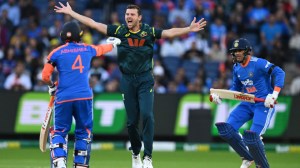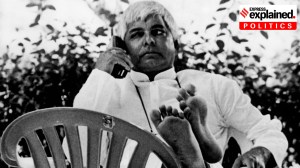Treasure your Crown Jewel
Irfan Pathan is an exciting revelation; as exciting as was Sachin Tendulkar when his Test career was launched all those years ago. Even here...

Irfan Pathan is an exciting revelation; as exciting as was Sachin Tendulkar when his Test career was launched all those years ago. Even here in South Africa there is a buzz of expectation about the 19-year-old from Vadodara. More interesting is how young African hopefuls in a township near Pretoria this past week looked wide-eyed and wondered from where he generates his pace and his swing.
This is something new and very special to the mighty sub-continent. Young Irfan has flair as well as impressive skills. As with Dennis Lillee, Sir Richard Hadlee, Kapil Dev and, for those who enjoy dipping into history, George Lohmann (who played in the 1880s and 1890s). Pathan is the inheritor of their pace and guile.
He should also become a protected species. While it is fun to bowl consistently at such speeds that would have traffic police dishing out speeding fines, Irfan does have one advantage that Ashish Nehra and Zaheer Khan — and even Balaji — do not: a smooth bowling action.
Memories of Hadlee and Ray Lindwall emerge as Irfan’s action is carefully studied and fitness levels are considered with someone who has such a wiry frame. It is easy, stylish and, though energetic, flows as smoothly as a sheet of silk when unwound from a roll. Yet, as with all such specialists, he needs to be regularly checked to allow time for recovery should he become injured.
Fanie de Villiers and Lillee had similar back problems early in their careers. To overcome a recurrence they embarked on specialised fitness courses. As there were no fitness specialists that all teams have today, it was a matter of checking it out with physiotherapist and orthopedic specialists to monitor progress.
‘‘Players coming back from an injury need close attention and monitoring’’, said Michael Holding when commenting on a problem that Fidel Edwards picked up on the Zimbabwe leg of the recent West Indies tour. ‘‘Prevention, though, is far better than cure and a period of rehabilitation and rebuilding their confidence that the injury will not occur again.’’
Holding escaped serious injury with his attention to bowling detail and technique. This has been supported by Lillee and De Villiers. It is a matter of bowling off a run up with which the bowler is comfortable. Built into this is the acceleration needed during the run-up to the point of delivery and body motion going into this movement and the follow-through. This is where the team’s fitness specialist plays a major role.
There is also a matter of dietary needs and physical training habits. In this respect each bowler is different. Irfan has a different sideways motion to that of Shoaib: one is smooth and flowing, the other is smooth yet whippy and inclined to place stress on parts of the body which take unnecessary strain.
Paddy Upton, formerly South Africa’s fitness trainer, was highly respected by all South African fast and swing bowlers of the 1990s. Upton feels that as fast bowling is an abnormal action and each person is built different, the bowler and their actions require a fitness technique regimen to suit their physical shape.
Groin strains, hamstring and shoulder injuries and knee strains develop because of bowling actions and the solution to this tricky issue is understanding the mechanics of fast bowling and what it takes out of the body. This is where talent spotted young in the colt or school days becomes important. Leave a bowler’s action alone, work on fitness levels and perhaps run up co-ordination, but not the follow through as that is where each bowler is different.
Clive Rice, when captain of Notts during 1980s, suggested to Hadlee that he shorten his run up to improve his accuracy and generate more swing and retain an injury-free summer in England. It worked: Hadlee increased his wicket-taking ability by more than 50 per cent in a short space of time. Hadlee, knew how important was fitness if he was to have a long career.
It is something that Team India’s management need to look at if they want to keep Irfan fit and active as a fast bowler for an extended period and make India a genuine world force.



- 01
- 02
- 03
- 04
- 05




























